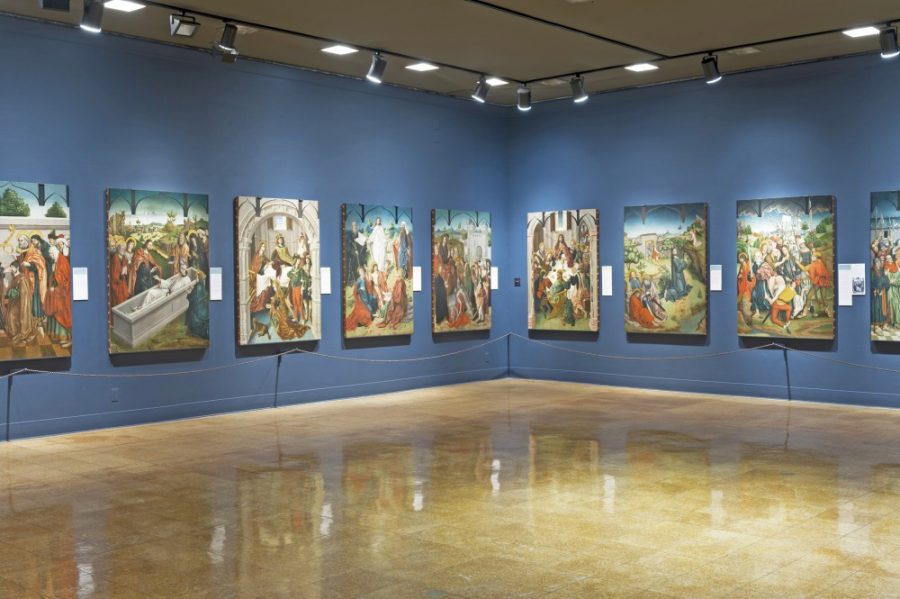On the second floor of the UA Museum of Art stands a fragile piece of Spanish history that has survived war, natural disaster and time itself. The retablo, or altarpiece, of Ciudad Rodrigo consists of several panels depicting religious Catholic artwork created from oil paint on wood.
The retablo was created in Ciudad Rodrigo in the province of Salamanca, Spain amidst the Spanish Renaissance, and has endured about 530 years of change. Between the years 1480 and 1488, Fernando Gallego and Maestro Bartolomé created the retablo in their workshops.
History conserved in artistry
In 1492, the Spanish expelled Muslim and Jewish people from the country. The retablo was seen as a representation of Catholicism, according to UAMA curator Olivia Miller.
The Hispano-Flemish style paintings tell the story of Jesus, starting with the creation of the universe and ending with the last judgment.
Miller said the retablo originally would have been framed with panels stacking together, but only 26 panels survived. The rest of the panels’ whereabouts remain a mystery. Miller believes there could have been at least 30 or more panels total with the altarpiece that would have only been displayed on special occasions.
RELATED: UA’s Special Collections: History at your fingertips
“In the 19th century when the Napoleonic wars were happening, that church was used as a lookout tower, and so it was bombed a lot,” Miller said. “So, one of our panels actually does still have a hole in it from one of those artillery.”
The retablo was donated as part of the Samuel H. Kress Collection in the early 1960s and it has lived in the museum since then.
Kress was a teacher who decided to open a unique “five and dime” store where all items cost five or ten cents. Eventually, he opened these S.H. Kress & Company stores nationwide. With his newfound wealth he collected artwork.
When Kress’ health began to decline he decided to give away his entire collection; most of it went to the National Gallery of Art in Washington D.C.
Astoundingly, the UAMA has a large portion of Kress’ collection because his sister-in-law was a UA alumna. Miller was told that the UA received the retablo because of Arizona’s connections to Mexico and Spain.
“What I think is always really interesting is to come to the museum and look at our altarpiece, and then go to San Xavier Mission and look at their altarpiece and kind of compare it and see how these cultures have blended,” Miller said.
Although it derives from religious significance, being Catholic is not a requirement to appreciate the artistic merits of the retablo.
“Even if you’re not interested in the subject matter, you can look at fifteenth century fashion,” Miller said. “All the figures are dressed in the clothes that people would have worn when the artists were making the paintings.”
Modern technology provides insight to artistic methods
There are two infrared reflector graphs on display at the UAMA. They are similar to x-rays and their function is to allow people to see the drawings underneath the painting. Miller said people can see where the artist changed their mind, or drew an outline.
According to Miller, carpenters and painters also contributed to the creation of the retablo. Through infrared technology, people can see Gallego’s handwriting underneath the painting where he left color notations for his assistants.
RELATED: UA museum highlights pharmacy history
These important pieces of artwork are preserved in a 72-degree, 45% humidity temperature-controlled room.
A lot of visitors come to see the altarpiece after watching “Secrets of the Divine: The Altarpiece of Ciudad Rodrigo”, an Arizona Public Media documentary about the retablo. Although most artwork cycles through the museum, the retablo remains on permanent display.
The UAMA is located next to the Marroney Theatre on Speedway Boulevard and Park Avenue. Admission is free with a CatCard, $8 for general admission and $6.50 for seniors 65 and over.
The museum is open everyday of the week. For museum hours and parking information visit their website.
Follow Maritza Cruz on Twitter.









